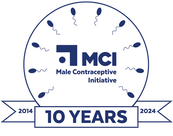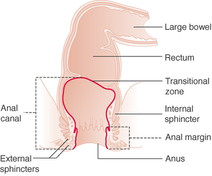|
(Source: Cancer Research UK) The anus is the opening at the end of the digestive tract where stool (or feces) leaves the body. This is not to be confused with the rectum, which is the section of the digestive tract above the anus where stool is held before it passes out of the body. In humans, the anus is the external opening of the rectum, located inside the intergluteal cleft, known colloquially as the butt crack, and separated from the genitals by the perineum. Its primary purpose is to control the exit of feces from the body during defecation. Two sphincters control its functioning: the internal anal sphincter and the external anal sphincter, which are circular-shaped muscles that normally constricts the orifice, and relaxes as required for normal functioning. The inner sphincter is involuntary and the outer is voluntary. It is located behind the perineum which is located behind the vagina in females or the scrotum in males. The anus can play a role in sexuality. Attitudes towards anal sex vary, and it is even illegal in some countries. The anus is often considered a taboo part of the body, and is known by many usually vulgar slang terms. Some sexually transmitted infections including HIV/AIDS and anal warts can be spread via anal sex. Nuts & Bolts: What is the Anus? To learn more about, please visit our series of posts about male reproduction and contraception: Key terms: Intergluteal cleft (gluteal cleft) - known by a number of synonyms, including natal cleft, butt crack, and cluneal cleft, this is the groove between the buttocks that runs from just below the sacrum to the perineum, so named because it forms the visible border between the external rounded protrusions of the gluteus maximus muscles. Perineum - the area between the anus and the scrotum or vulva. Rectum - the terminal part of the intestine from the sigmoid colon to the anus. For additional terminology related to male contraception and the male reproductive system, please visit our glossary: Sources/References: Jorge JM, Wexner SD. Anatomy and physiology of the rectum and anus. Eur J Surg. 1997 Oct;163(10):723-31. PMID: 9373222. Holschneider AM, Freeman NV. Anatomy and function of the normal rectum and anus. Birth Defects Orig Artic Ser. 1988;24(4):125-54. PMID: 3067760. Kumar L, Emmanuel A. Internal anal sphincter: Clinical perspective. Surgeon. 2017 Aug;15(4):211-226. doi: 10.1016/j.surge.2016.10.003. Epub 2016 Nov 20. PMID: 27881288. Naftalin RJ. Anal sex and AIDS. Nature. 1992 Nov 5;360(6399):10. doi: 10.1038/360010c0. PMID: 1285802. Voeller B. AIDS and heterosexual anal intercourse. Arch Sex Behav. 1991 Jun;20(3):233-76. doi: 10.1007/BF01541846. PMID: 2059146. For additional publications related to male contraception and the male reproductive system, please visit our publications page:
Comments are closed.
|
Categories
All
Archives
June 2024
|
|
|
Donate to Male Contraceptive InitiativeYour generous donation makes a difference!
|
© Male Contraceptive Initiative. All rights reserved.


 RSS Feed
RSS Feed
